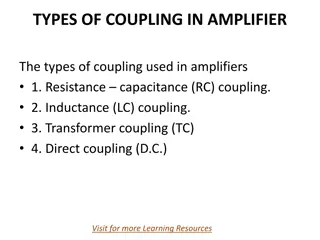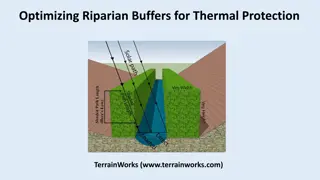Multiphysics Coupling for Thermal Connection in COMSOL
Establishing continuity of temperatures between volume and shell domains through surfaces in a model can reduce computational costs. Learn how to set up the Thermal Connection, Layered Shell, Surfaces multiphysics coupling node in COMSOL for heat transfer simulations. Compare results between configurations with different interfaces to understand the impact on temperature distribution.
Download Presentation

Please find below an Image/Link to download the presentation.
The content on the website is provided AS IS for your information and personal use only. It may not be sold, licensed, or shared on other websites without obtaining consent from the author.If you encounter any issues during the download, it is possible that the publisher has removed the file from their server.
You are allowed to download the files provided on this website for personal or commercial use, subject to the condition that they are used lawfully. All files are the property of their respective owners.
The content on the website is provided AS IS for your information and personal use only. It may not be sold, licensed, or shared on other websites without obtaining consent from the author.
E N D
Presentation Transcript
Background Volumes can become a source of a large amount of degrees of freedom in a model, inducing a large computational cost. Certain parts of models can be simplified to shells to reduce this cost, but others may need to remain volumes. In such cases, the multiphysics coupling node Thermal Connection, Layered Shell, Surfaces establishes the continuity of the temperatures between the volume domains and shell domains through surfaces. This tutorial model shows how to setup the coupling node, and test the results of a configuration combining Heat Transfer in Solids and Heat Transfer in Shells interfaces versus this same configuration with only a Heat Transfer in Solids interface.
Model Definition Top shell In the both configurations, the main bodies are made of copper, the layered domains are made of an aluminum layer and a silica glass layer. Central shell Bottom shell Copper body In reference configuration, the layered domains are connected to the main bodies by shared boundaries. All domains are modeled as volumes. Silica glass layer Aluminum layer In the shell configuration, the layered domains are modeled as shells. Model geometry
Model Definition Fixed temperature In the both configurations, fixed varying temperatures are applied on the bottom and top boundaries Thermal insulation Fixed temperature In the reference configuration, temperature continuities between the bodies and the layered domains is naturally ensured by the contact of the solids Fixed temperature Fixed temperature In the shell configuration, a thermal insulation condition is applied on half of the internal shared boundary to reproduce the gap of the reference configuration. The temperature continuities are ensured by the coupling node Model boundary conditions
Results Temperatures vary continuously between the bodies and the layered domains The shell configuration reproduces the behavior of the reference configuration Temperature distribution
Results The figure shows the temperatures through the thickness in the layered domains for all three tested locations The shell configuration matches with the reference configuration thanks to the Thermal Connection, Layered Shell, Surfaces multiphysics coupling Temperature comparison in the layered domains























